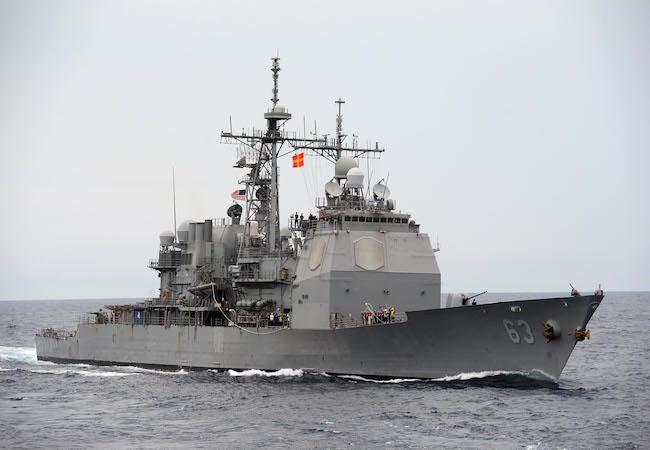South China Sea is the real global flashpoint

By Azhar Azam
So many times over the past few years, the U.S. federal administration, establishment, and media have collectively fussed about the national security threats from Iran but all of them eventually have fizzled out only after a short-lived bedlam.
The ongoing hype should also wane soon as the USS Abraham Lincoln aircraft carrier strike group has reached in the Persian Gulf. And now the U.S. will quickly focus back on its real interest that lies in South China Sea and not in Iran or Arabian Sea.
Indications are clear. Last week, Senator Marco Rubio and Senator Ben Cardin yoked to reintroduce a bipartisan legislation – South China Sea (SCS) and East China Sea (ECS) Sanctions Act – which proposes to impose sanctions on Chinese individuals and entities that are engaged in maritime and construction activities in the regions.
China claims 90% of the sea and airspace in South China Sea while Taiwan, the Philippines, and Vietnam are the other major claimants in the region. Japan and South Korea contest with China for the control over East China Sea.
For the United States, SCS is the region of vital interest because of its political, trade, and strategic importance. It insists SCS is an international waterway that gives all countries the freedom to navigate. Therefore, it has been mindful of Beijing’s island-building and militarization affairs in the region.
These days, some anomalous events are taking place in SCS. After sending two warships close to Spratly Islands and concluding military drills with India, Japan, and the Philippines – the U.S. just recently sailed a destroyer near the Scarborough Shoal. Chinese foreign ministry strongly hit back at the U.S. “provocative action” that violates its “national sovereignty”.
Experts covet that Scarborough Shoal is potentially a powder keg in the strategic waterway, through which China could create a large “strategic triangle” comprising Woody Island in the Paracel Islands to the northwest and its Spratly islet outposts to the south. It was captured by China after a long standoff with the Philippines in 2012.
So, Washington is distinctly trying to increase pressure on Beijing by frequently conducting freedom of navigation operations (FONOPs). But it also carefully circumventing a direct confrontation with China and instead is pushing its allies – Australia and Indonesia – to step up naval patrols in the area to counter Beijing’s growing strength.
Curtly for the U.S., Canberra does not have any claims in SCS and also it has high economic stakes in Beijing. It therefore is unlikely to antagonize China and that too at time when it is seeking to ramp-up its LNG exports to China amidst escalating Sino-US trade tensions. Although Australian naval forces have been sailing through SCS but that are looking more to gladden Washington than to challenge China’s dominance in the area.
China and Indonesia have disputes on Natuna Sea but both the countries have managed to play down the territorial differences and cooperate economically. Additionally, Jakarta is also looking to close the trade gap with China and in an era of economic struggle, it is highly implausible that it would litter ties with Beijing. Empirically, Indonesia seems to be contending with China’s opponents in South China Sea.
India could be another American partner to contain Chinese influence in SCS. Earlier this month, U.S. chief of naval operations Admiral John Richardson visited New Delhi, ostensibly to forge an alliance to prevent China’s preeminence in SCS. As always, Indian experts pungently backed Richardson’s views about China’s naval push as a concern to both India and the United States.
India neither has any claims in South China Sea but it has been balking to accept on the Pakistani-arm of Chinese Belt and Road Initiative (BRI) and has long rivalry with Beijing. The problem with New Delhi is that it wants to mend its relations with Beijing but at the same time, it invariably pursues any idea that could bite China.
That is why every time when there is an American official in New Delhi, ‘every Tom, Dick, and Harry’ talks about smarting China through partnering and sustaining a propelling relationship with the United States.
United States is also relying on the Philippines and Vietnam to spark a conflict with China in SCS. Both of them are major claimants in the SCS are critical of Beijing’s activities in the area. But SCS brawl is yet to enervate the bilateral relations of the either of them with Beijing, instead the Philippines and Vietnam maintain good ties with China.
Last week, commander of U.S. Pacific Air Forces Gen Charles Brown visited Manila to meet the top military officials including the chief of general staff Gen Benjamin Madrigal and discussed the prospects of increased multilateral training between the two sides. Gen Brown spearheads U.S. jet patrols in SCS. Meanwhile, the coastguard ships of the Philippines and the U.S also conducted joint naval drills in the region.
By all means, war with Iran could be the dream of the likes of John Bolton nonetheless energy-rich South China Sea will inevitably be the real global flashpoint that would attract the conflict among several states including China and the United States.
Based in Pakistan, Azhar Azam works in a private organization as “Market & Business Analyst” and writes on geopolitical issues and regional conflicts.




